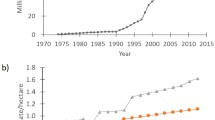Abstract
A study was conducted to determine whether stand densities of transgenic cotton (Gossypium hirsutum) varieties, with or without glyphosate, were similar to conventional varieties of the same lineage group in Georgia and Mississippi. Transgenic and conventional cotton varieties were placed into five lineage groups of related varieties and seedling disease was evaluated in three greenhouse tests and a field trial using Rhizoctonia solani AG-4. Seed vigor was determined by standard germination studies were conducted evaluating conventional and transgenic varieties of similar lineage. Results showed that no interactions occurred for the heights and dry weight data across treatments within the lineage groups in any of the experiments. No interactions were shown between stand densities at different inoculum rates and inoculated versus uninoculated pots (plots). Across all greenhouse studies, stand counts of PM 1220 were similar to the transgenic varieties PM 1220 RR and PM 1220 B/RR with or without a glyphosate application. In the field trial, PM 1220 B/RR + glyphosate had significantly lower stands than all other treatments expect PM 1220 RR (no glyphosate treatment) prior to and after glyphosate application. Stand densities for varieties within the lineage group DPL 5415 were also inconsistent when compared between the greenhouse and field trials with no apparent trends occurring. However, the Coker 312 varieties containing glyphosate tolerance had consistently lower stand counts compared to the conventional variety of Coker 312 but only during the greenhouse studies. Seed germination of Coker 312 could not be correlated with either the greenhouse or field trial data. In general, the commercially available varieties such as PM 1220, DPL 5690, DPL 5415, and DPL 50 with glyphosate tolerance had similar stand count, height, and dry weight data when compared to the conventional varieties from the same lineage group regardless of a glyphosate application. When differences did occur, no consistent trends could be determined within these four lineage groups.
Similar content being viewed by others
References
JF Bradley (2000) ArticleTitleEconomic comparison of weed control systems in conservation tillage systems. Proc. Beltwide Cotton Conf., Memphis, TN 2 1474–1476
JE Carpenter LP Gianessi (2000) ArticleTitleValue of BT and herbicide resistant cottons. Proc. Beltwide Cotton Conf., Memphis, TN 1 76–79
Keeling JW, Dotray PA, Osborne TS, Everitt JD. Weed management in roundup ready (Glyphosate-tolerant) cotton: conventional and conservation tillage systems. Proc Beltwide Cotton Conf Memphis TN 2000; 2:1477.
MB Layton MR Williams JL Long (1999) ArticleTitlePerformance of Bt cotton in Mississippi. Proc Beltwide Cotton Conf Memphis TN 2 1037–1039
Stewart SD, Knighten KS, Davis FM. Efficacy of Bt cotton expressing two insecticidal proteins of Bacillus thuringiensis berliner on selected caterpillar pests. 2000; 2: 1043–1048.
R Vargas (1999) ArticleTitleRoundup ready cotton in California. Proc Annu Calif Weed Sci Soc Fremont CA 51 28–29
JH Benedict (1996) ArticleTitleBt cotton: opportunities and challenges. Proc Beltwide Cotton Conf Memphis TN 1 25–29
MA Jones CE Snipes (1999) ArticleTitleTolerance of transgenic cotton to topical applications of glyphosate. The J Cotton Sci 3 19–26 Occurrence Handle1:CAS:528:DC%2BD3cXmtVejsrw%3D
RS Baker (1993) ArticleTitleResponse of cotton (Gossypium hirsutum) to preplant-applied hormone-type herbicides Weed Technol 7 150–153 Occurrence Handle1:CAS:528:DyaK3sXkt1aktLw%3D
BR Jr. Corbin RE Frans (1991) ArticleTitleProtecting cotton (Gossypium hirsutum) from fluometuron injury with seed protectants. Weed Sci 39 408–411 Occurrence Handle1:CAS:528:DyaK38Xit1Gm
Keeling JW, Abernathy JR. Preemergence weed control in a conservation tillage cotton (Gossypium hirsutum) cropping systems on sandy soils 1989; 3: 182–185.
JW Keeling CG Henniger JR Abernathy (1993) ArticleTitleEffects of DPX PE350 on cotton (Gossypium hirsutum) growth, yield, and fiber quality. Weed Technol 7 930–933 Occurrence Handle1:CAS:528:DyaK2cXktVeiur0%3D
CA Levesque JE Rahe (1992) ArticleTitleHerbicide interactions with fungal root pathogens, with special reference to glyphosate. Annu Rev Phytopathol 30 579–602 Occurrence Handle10.1146/annurev.py.30.090192.003051 Occurrence Handle1:CAS:528:DyaK38XmtVKqtbY%3D Occurrence Handle18647104
Ragab MM, Youssef BA, Moustafa-Mahmoud SM. Interaction between certain herbicides and seed dressing fungicides with reference to the control of Rhizoctonia solani in cotton. Proc Congr Egypt Phytopathol Soc Giza 1987; 331–346.
BA Youssef MM Ragab SM Moustafa-Mahmoud (1987) ArticleTitleEffect of herbicides on the incidence of Rhizoctonia solani infection and certain cellular components of cotton plants Agric Res Rev 65 153–160
SM Moustafa-Mahmoud DR Sumner (1993) ArticleTitleInteraction of fungicides, herbicides, and planting date with seedling disease of cotton caused by Rhizoctonia solani AG-4. Plant Dis 77 79–86 Occurrence Handle1:CAS:528:DyaK3sXhsVWksbs%3D Occurrence Handle10.1094/PD-77-0079
Dorris EA. The letter of the law: What you can do if your seed fails to perform. Mississippi Farmer (June). 1999; 10–11.
Baird RE. Cotton disease and their control. Univ. of Georgia Coop. Ext Ser Ext Bull 1996; 1143. 8p.
RG Davis (1975) ArticleTitleMicroorganisms associated with diseased cotton seedlings in Mississippi. Plant Dis Rep 59 277–280
Neal DC. Cotton Diseases in Mississippi and their control. Agric College MS Mississippi Agric Exp Sta Bull 1928; 30, 3.
InstitutionalAuthorNameAssociation of Official Seed Analysts (1978) ArticleTitleRules for testing seeds J. Seed Technol 3 IssueID3 1–126
MP Greaves JA Sargent (1986) ArticleTitleHerbicide-induced microbial invasion of plant roots. Weed Sci 34 50–53 Occurrence Handle1:CAS:528:DyaL28Xlt12hur8%3D
GS Johal JE Rahe (1990) ArticleTitleRole of phytoalexins in the suppression of resistance of Phaseolus vulgaris to Colletotrichum lindemuthianum by glyphosate Can. J Plant Pathol 12 225–235 Occurrence Handle1:CAS:528:DyaK3MXlsl2mt78%3D Occurrence Handle10.1080/07060669009500992
Kaps MA, Kuhns LJ. Glyphosate transfer between plants via mycorrhizal fungi. HortScience 1987; 22: 1128. (Abstract).
Author information
Authors and Affiliations
Corresponding author
Additional information
An erratum to this article is available at http://dx.doi.org/10.1007/s11046-005-4021-3.
Rights and permissions
About this article
Cite this article
Baird, R., Batson, W., Watson, C. et al. Evaluation of transgenic cotton varieties and a glyphosate application on seedling disease incidence. Mycopathologia 158, 363–368 (2004). https://doi.org/10.1007/s11046-004-2303-9
Received:
Accepted:
Issue Date:
DOI: https://doi.org/10.1007/s11046-004-2303-9




